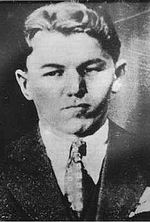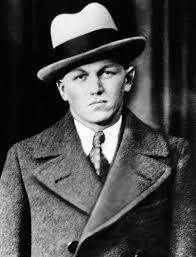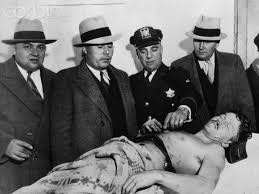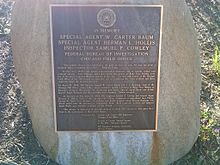News: Greenwood ("Baby Face" Nelson Visits – 28
Apr 1934)
Contact:
stan@wiclarkcountyhistory.org
Surnames: Nelson, Gregorich
----Source: Greenwood Gleaner (Greenwood, Clark Co., Wis.) 03 May 1934, Wikipedia Encyclopedia

George "Baby Face" Nelson, outlaw and killer, visited Greenwood (Clark Co.,
Wis.) early last Friday. He stopped at the Joe Gregorich farm, 2 1/2 miles north
of here, where he had breakfast and then was taken to Marshfield by Mr.
Gregorich.
At Marshfield Nelson purchased a second had Chevrolet Coach and made his get
away without anyone knowing he had been there.
Upon returning from Marshfield, Mr. Gregorich reported to local officers his
suspicions and a checkup was made of the car left at the Gregorich farm, and
found to be the one which Nelson stole and escaped in from the north woods.
Mr. Gregorich's story of the incident follows:
"A man drove in my yard about 5 a.m. Friday. He parked his car in the shed and
came to the house. We were just getting up.
"The man had about four days growth of beard on his face. He wore a checkered
shirt, brown and gray tweed trousers and heavy shoes like the CCC boys wear.
"When we went to the door he asked, 'Have you a radio in the house?' We said no.
"Then he said he wanted to get to Neillsville, as his car broke down. I said I
did not think I could make it without a car license.
"Then he asked for breakfast. He took his coat off very carefully and laid it
beside him and washed his face, but he watched me all the time. He took an
interest in the baby.
"After a breakfast of eggs, buns, jam and coffee, we went outside. He wanted to
know if that was our usual breakfast. I said yes, times were hard and we could
not afford anything better. He said, there's $20. Go and buy some groceries when
you get back. I did not want to take the money, but he insisted.
"He followed me everywhere while I did my chores, and would not let me out of
his sight. The way he acted made me suspicious. Once he asked me, 'Who do you
thin I am, Dillinger?' I said 'no, but you may be one of his gang.'
"Oh boy, that's good, eh said, laughing. "I'll have to tell my ma about that."
"Before he left, he saw a razor in the house and said he would like to have, but
did not have the time. When we were ready to leave, he played with the baby
again and said he was married and had one of his own.
"We stopped at a filling station in Greenwood, but he did not let me get out of
the car. On the way he asked me, 'Are there any motorcycle officers on Highway
73 to Neillsville?' When I said there was, he said 'We will go to Marshfield, by
way of Loyal. He had a road map of Wisconsin.
"At Loyal we stopped for gas and oil, but he did not let me get out. He said to
be sure and see that there was oil enough. On the way to Marshfield he gave me a
package of cigarettes, but I could not get the cellophane of, and he said, 'give
them to me, you are too nervous. I'll open them for you.' When he go to
Marshfield he wanted me to stop at a drugstore, but I did not want to go on
Central Avenue because I had no license plates.
"He peeled of another $10 and said, 'Her is $10 for your license and if you get
pinched, I'll pay your fine.' When he ad given me the $20 he said, 'I have lots
of money now, but maybe 20 years from now you will have more than I will.'
"He got off near North Central Avenue in Marshfield and shook hands and said,
'I'll see you in a few days.' He said he would send me a mechanic for the car
and I should let him have it."
Biography of Lester Joseph Gillis - aka Baby Face Nelson

Lester Joseph Gillis (December 6, 1908 – November 27, 1934), known under the
pseudonym George Nelson, was a bank robber and murderer in the 1930s. Gillis was
better known as Baby Face Nelson, a name given to him due to his youthful
appearance and small stature. Usually referred to by criminal associates as
"Jimmy", Nelson entered into a partnership with John Dillinger, helping him
escape from prison in the famed Crown Point, Indiana Jail escape, and was later
labeled along with the remaining gang members as public enemy number one.
Nelson was responsible for the murder of several people, and has killed more FBI
agents in the line of duty than any other person. Nelson was shot by FBI agents
and died after a shootout often termed "The Battle of Barrington".
Early life
July 4, 1921, at the age of twelve, Nelson was arrested after accidentally
shooting a fellow child in the jaw with a pistol he had found. He served over a
year in the state reformatory. Arrested again for theft and joyriding at
age 13, he was sent to a penal school for an additional 18 months.
In 1928 Nelson met and married Helen Wawzynak. The couple had two children.
By the time he met Helen, Nelson was working at a Standard Oil station in his
neighborhood that was the headquarters of young tire thieves, known as
"strippers". After falling in with them, Nelson became acquainted with many
local criminals, including one who gave him a job driving bootleg alcohol
throughout the Chicago suburbs. It was through this job that Nelson became
associated with members of the suburban-based Touhy Gang (not the Capone mob, as
usually reported). Within two years, Nelson and his gang had graduated to armed
robbery. On January 6, 1930, they invaded the home of magazine executive Charles
M. Richter. After trussing him up with adhesive tape and cutting the phone
lines, they ransacked the house and made off with $25,000 worth of jewelry. Two
months later, they carried out a similar theft in the Sheridan Road bungalow of
Lottie Brenner Von Buelow. This job netted $50,000 in jewels, including the
wedding ring of the bank's owner. Chicago newspapers nicknamed them "The Tape
Bandits."
On April 21, 1933, Nelson robbed his first bank, making off with $4,000. A month
later, Nelson and his gang pulled their home invasion scheme again, netting
$25,000 worth of jewels. On October 3 of that year, Nelson hit the Itasca State
Bank for $4,600; a teller later identified Nelson as one of the robbers. Three
nights later, Nelson stole the jewelry of the wife of Chicago mayor Big Bill
Thompson, valued at $18,000. She later described her attacker this way, "He had
a baby face. He was good looking, hardly more than a boy, had dark hair and was
wearing a gray topcoat and a brown felt hat, turned down brim." Years later,
Nelson and his crew were linked to a botched roadhouse robbery in Summit,
Illinois on November 23, 1930 that resulted in gunplay that left three people
dead and three others wounded. Three nights later, the Tape Bandits hit a
Waukegan Road tavern, and Nelson ended up committing his first murder of note,
when he killed stockbroker Edwin R. Thompson
Going west
Throughout the winter of 1931, most of the Tape Bandits were rounded up,
including Nelson. The Chicago Tribune referred to their leader as "George 'Baby
Face' Nelson" who received a sentence of one year to life in the state
penitentiary at Joliet. In February 1932, Nelson escaped during a prison
transfer. Through his contacts in the Touhy Gang, Nelson fled west and took
shelter with Reno gambler/crime boss William Graham. Using the alias of "Jimmy
Johnson", Nelson wound up in Sausalito, California, working for bootlegger Joe
Parente. During these San Francisco Bay area criminal ventures, Nelson most
probably first met John Paul Chase and Fatso Negri, two men who were at his side
during the later half of his career. While in Reno the next winter, Nelson first
met the vacationing Alvin Karpis, who in turn introduced him to Midwestern bank
robber Eddie Bentz. Teaming with Bentz, Nelson returned to the Midwest the next
summer and committed his first major bank robbery in Grand Haven, Michigan on
August 18, 1933. The robbery was a near-disaster, even though most of those
involved made a clean getaway.
Gang leader
The Grand Haven bank job apparently convinced Nelson he was ready to lead his
own gang. Through connections in St. Paul's Green Lantern Tavern, Nelson
recruited Homer Van Meter, Tommy Carroll, and Eddie Green. With these men (and
two other local thieves), Nelson robbed the First National Bank of Brainerd,
Minnesota of $32,000 on October 23, 1933. Witnesses reported that Nelson wildly
sprayed sub-machine gun bullets at bystanders as he made his getaway. After
collecting his wife Helen and four-year old son Ronald, Nelson left with his
crew for San Antonio, Texas. While here, Nelson and his gang bought several
weapons from underworld gunsmith Hyman Lehman. One of those weapons was a .38
Colt automatic pistol that had been modified to fire fully automatic (Nelson
used this same gun to murder Special Agent W. Carter Baum at Little Bohemia
Lodge several months later).
By December 9, a local woman tipped San Antonio police to the nearby presence of
"high powered Northern gangsters". Two days later, Tommy Carroll was cornered by
two detectives and opened fire, killing Detective H. C. Perrin and wounding
Detective Al Hartman. All the Nelson gang, except for Nelson, fled San Antonio.
Nelson and his wife traveled west to the San Francisco Bay Area, where he
recruited John Paul Chase and Fatso Negri for a new wave of bank robberies in
the coming spring.
A Short but Furious Gun Battle between FBI agents and Nelson took place
on November 27, 1934, outside Chicago in the town of Barrington, resulting in
the deaths of Nelson and FBI Special Agents Herman "Ed" Hollis and Samuel P.
Cowley.[
The prelude to the Barrington gun battle began with Nelson, along with Helen
Gillis and John Paul Chase, heading south in a stolen V8 Ford towards Chicago on
State Highway 14. Nelson, always keen to spot G-Men, caught sight of a sedan
driven in the opposite direction by FBI agents Thomas McDade and William Ryan.
Nelson hated police and federal agents and used a list of license plates he had
compiled to hunt them at every opportunity. The agents and the outlaw
simultaneously recognized each other and after several U-turns by both vehicles,
Nelson wound up in pursuit of the agents' car. Nelson and Chase fired at the
agents and shattered their car's windshield. Ryan and McDade sped up then
skidded into a field and anxiously awaited Nelson and Chase, who had stopped
pursuing. The agents did not know that a shot fired by Ryan had punctured the
water pump of Nelson's Ford or that the Ford was being pursued by a Hudson
automobile driven by two more agents: Herman Hollis (who was alleged to have
delivered the fatal shot to a wounded John Dillinger a few months earlier and
Cowley. As a result, Ryan and McDade were oblivious to the events that happened
next.
With his vehicle losing power and his pursuers attempting to pull alongside,
Nelson swerved into the entrance of Barrington's North Side Park and stopped
opposite three gas stations. Hollis and Cowley overshot them by over 100 feet
(30 m), stopped at an angle, exited their vehicle's passenger door, under heavy
gun fire from Nelson and Chase, and took cover behind the car. The ensuing
shootout was witnessed by more than 30 people.
Just after Helen Gillis fled into a ditch under instructions from Nelson, Nelson
was mortally wounded. He grasped his side and sat down on the running board as
Chase continued to fire from behind their car. Nelson, advancing toward the
agents, fired so rapidly with a .351 rifle that bystanders mistook it for a
machine gun. Six bullets from Cowley's submachine gun eventually struck Nelson
in the chest and stomach before Nelson mortally wounded Cowley with bullets to
the chest and stomach, while pellets from Hollis's shotgun struck Nelson in the
legs and knocked him down. As Nelson regained his feet, Hollis, possibly already
wounded, moved to better cover behind a utility pole while drawing his pistol
but was killed by a bullet to the head before he could return fire. Nelson stood
over Hollis's body for a moment, then limped toward the agents' car. Nelson was
too badly wounded to drive, so Chase got behind the wheel and the two men and
Nelson's wife fled the scene. Nelson had been shot seventeen times; seven of
Cowley's bullets had struck his torso and ten of Hollis's shotgun pellets had
hit his legs.[46] After telling his wife "I'm done for", Nelson gave directions
as Chase drove them to a safe house on Walnut Street in Wilmette. Nelson died in
bed with his wife at his side, at 7:35 p.m. Wikipedia Encyclopedia

Death of Baby Face Nelson
 |
A plaque at the Barrington Park District in Barrington, Illinois, commemorates
the site of the Battle of Barrington, a 1934 shootout that claimed the lives of
two FBI agents and resulted in the death of notorious Chicago gangster Baby Face
Nelson. |




